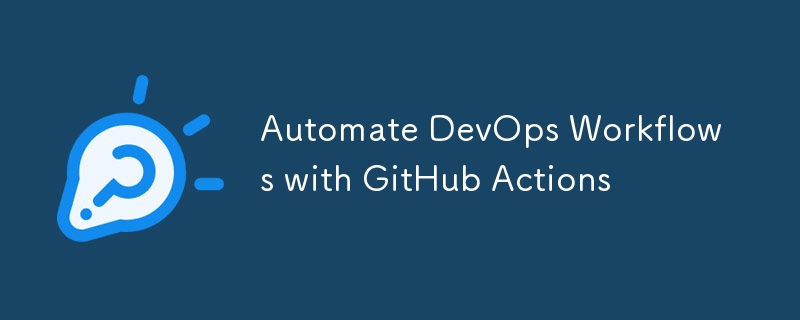Home >Backend Development >Python Tutorial >Automate DevOps Workflows with GitHub Actions
Automate DevOps Workflows with GitHub Actions
- Susan SarandonOriginal
- 2024-11-11 03:37:02823browse

Author: Trix Cyrus
Waymap Pentesting tool: Click Here
TrixSec Github: Click Here
What Is GitHub Actions?
GitHub Actions is an automation tool integrated into GitHub, offering the capability to automate workflows, CI/CD pipelines, testing, code quality checks, and even deployments directly within your repository. It enables you to define workflows using YAML files, giving you full control over triggers, environments, and tasks.
Why Use GitHub Actions for DevOps?
- Integrated with GitHub: Seamlessly integrate with GitHub repos, issues, and pull requests.
- Scalable CI/CD Pipelines: Run builds, tests, and deployments on various platforms.
- Customizable Workflows: Define workflows that match your exact needs, from simple tasks to complex multi-step processes.
- Reusable Workflows: Share reusable workflows and custom actions across multiple projects.
Key Components of GitHub Actions
- Workflows: Automated processes defined in YAML files stored in the .github/workflows directory.
- Jobs: Each workflow is made up of jobs that can run concurrently or sequentially.
- Steps: Each job has a series of steps, which may include running commands, scripts, or reusable actions.
- Triggers: Define events that trigger a workflow, such as push, pull_request, schedule, etc.
Setting Up Your First DevOps Workflow
Let's walk through creating a basic CI workflow to test and build your code whenever a new commit is pushed.
Create the Workflow File
Navigate to .github/workflows in your repository and create a file named ci.yml.Define the Workflow Structure
name: CI Workflow
on:
push:
branches:
- main
pull_request:
branches:
- main
jobs:
build:
runs-on: ubuntu-latest
steps:
- name: Checkout code
uses: actions/checkout@v3
- name: Set up Node.js
uses: actions/setup-node@v3
with:
node-version: '16'
- name: Install dependencies
run: npm install
- name: Run tests
run: npm test
- name: Build project
run: npm run build
- Explanation of the Workflow
- Triggers (on): The workflow triggers on push or pull_request events targeting the main branch.
- Jobs: We have a single build job that installs dependencies, runs tests, and builds the project.
- Steps: Each step uses actions or commands (e.g., actions/checkout for checking out the code, actions/setup-node for setting up Node.js, and various npm commands).
Adding Linting and Code Quality Checks
To ensure code quality, you can add a linting step to your workflow.
- name: Lint code run: npm run lint
Adding this step after Install dependencies helps identify code quality issues early in the pipeline.
Automating Deployments with GitHub Actions
Now, let’s add an automated deployment step to a cloud service, such as AWS or Firebase.
Example: Deploy to Firebase
Set up Firebase CLI
First, install and configure Firebase CLI on your local machine. Generate a token with firebase login:ci and store it as a GitHub secret (FIREBASE_TOKEN).Add the Deployment Step
name: CI Workflow
on:
push:
branches:
- main
pull_request:
branches:
- main
jobs:
build:
runs-on: ubuntu-latest
steps:
- name: Checkout code
uses: actions/checkout@v3
- name: Set up Node.js
uses: actions/setup-node@v3
with:
node-version: '16'
- name: Install dependencies
run: npm install
- name: Run tests
run: npm test
- name: Build project
run: npm run build
Here, we specify needs: build, meaning this deployment job runs only after the build job completes successfully.
Advanced GitHub Actions Tips
- Use Caching: Speed up workflows by caching dependencies.
- name: Lint code run: npm run lint
- Matrix Builds: Test across multiple versions or platforms using matrix strategies.
deploy:
needs: build
runs-on: ubuntu-latest
steps:
- name: Checkout code
uses: actions/checkout@v3
- name: Set up Node.js
uses: actions/setup-node@v3
with:
node-version: '16'
- name: Install dependencies
run: npm install
- name: Build project
run: npm run build
- name: Deploy to Firebase
env:
FIREBASE_TOKEN: ${{ secrets.FIREBASE_TOKEN }}
run: |
npm install -g firebase-tools
firebase deploy
- Secrets and Environment Variables: Store sensitive information in GitHub Secrets and access them using ${{ secrets.SECRET_NAME }}.
Monitoring and Debugging Workflows
- View Logs: Each step in GitHub Actions generates logs accessible from the Actions tab.
- Debug Mode: Add ACTIONS_STEP_DEBUG in secrets with value true for verbose logging.
- Error Notifications: Set up notifications (e.g., Slack or email) to receive alerts on workflow failures.
Reusable Workflows
As your projects grow, consider creating reusable workflows by defining workflow_call in your YAML file and reusing across multiple repositories, especially for tasks like code formatting or security scans.
Wrapping Up
Automating DevOps workflows with GitHub Actions enhances productivity, reduces human error, and creates a more robust CI/CD pipeline. With workflows running seamlessly in the background, developers can focus more on writing code and less on deployment tasks. Start small with testing and gradually expand to deploying and monitoring to maximize GitHub Actions' potential in your DevOps journey.
This guide provides a foundation for building, testing, and deploying your projects with GitHub Actions. Once comfortable, you can expand further with custom actions, integrations, and advanced automation for a fully optimized DevOps pipeline.
~TrixSec
The above is the detailed content of Automate DevOps Workflows with GitHub Actions. For more information, please follow other related articles on the PHP Chinese website!

